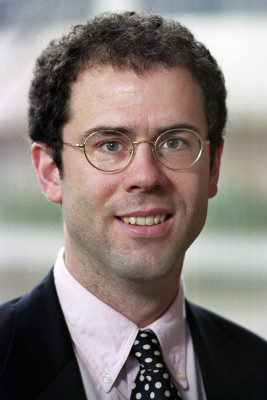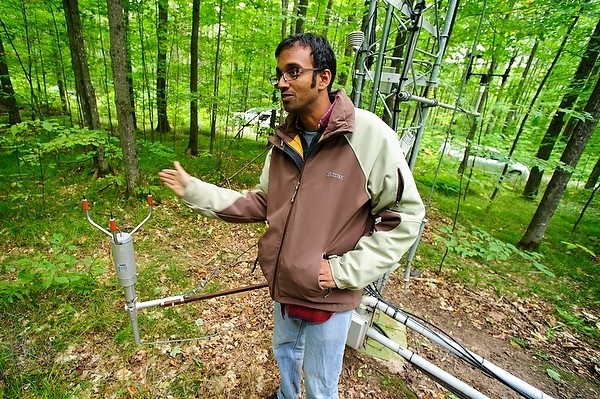2016 AMS Awards: Johnson, Martin, Desai recognized for contributions to field
The American Meteorological Society (AMS) will honor three scientists from the University of Wisconsin-Madison’s Department of Atmospheric and Oceanic Sciences (AOS) – emeritus professor Donald Johnson, professor and former department chair Jonathan Martin, and associate professor and graduate student chair Ankur Desai – at an awards ceremony to be held at the annual AMS meeting in January 2016.

Don Johnson speaking at the Space Science and Engineering Center (SSEC) 50th anniversary program in September 2015. Credit: Bill Bellon, SSEC.
Johnson, who is an AMS fellow and former AMS president, will become an honorary member of the AMS. The honorary title is a reflection of his years of service to the AMS and the scientific community at large, which has benefitted greatly from his contributions over the years.
Johnson earned bachelor’s degrees in mathematics, chemistry, and meteorology, and served for seven years as a meteorologist on active duty in Europe and the United States for the U.S. Air Force, before coming to Wisconsin in 1959. He received his master’s degree in 1960 and his Ph.D. in 1965 from UW-Madison, where he taught for 30 years.
Johnson was the inaugural associate director of the Space Science and Engineering Center (SSEC) as well as an early interim director for the Cooperative Institute for Meteorological Satellite Studies (CIMSS) on the UW-Madison campus. He led numerous scientific committees, and was committed to the education of young scientists in addition to conducting his own research.
“Students were always a high priority,” he recalled recently. “I made sure I was always there to help if they needed it, but I didn’t dictate what they needed to do. I offered a list of options and they could decide from there.”
Johnson realized the potential to use emerging scientific technologies – such as the Man-computer Interactive Data Access System (McIDAS), a revolutionary satellite data visualization tool developed at SSEC in the 1970s – for educational purposes. Starting in 1981, Johnson led the development of a series of video modules for teaching atmospheric sciences. More than 100 universities and organizations worldwide implemented the modules, upending traditional approaches to science education.
To further that program, Johnson accepted a position with the Universities Space Research Association (USRA) in the early 1990s, securing NASA funding to develop the first-ever curriculum for Earth system science education.
“That was the beginning of science, technology, engineering, and math, or STEM, education,” he said.
Johnson has been recognized by the AGU and AMS for his contributions to STEM education, and is a fellow of the American Association for the Advancement of Science. Upon receiving an AMS excellence in teaching award in 2005, Johnson said, “Students, through research and discussions, are the stimulus and life blood that professors enjoy.”
Johnson continues to mentor former students and colleagues, including National Weather Service director Louis Uccellini. At the day-long Donald R. Johnson symposium hosted by the AMS in 2014, Uccellini remarked that much of what is known today about the “Earth’s wondrous atmospheric circulation regimes” is due in part to Johnson’s lifelong research efforts.

Jonathan Martin, atmospheric and oceanic sciences professor at the University of Wisconsin-Madison. Credit: Jeff Miller, UW Communications.
Another driven educator, Martin will receive the Edward N. Lorenz Teaching Excellence Award, in recognition of his “outstanding teaching and mentoring that combine boundless enthusiasm with consummate skill to educate and inspire a generation of undergraduate and graduate students.”
Martin began teaching at UW-Madison in 1994. He was inspired to teach early on, having not only a number of influential undergraduate professors, but also a family tradition of educators.
“My parents were both teachers, many of my aunts and uncles were teachers, so there was always an ethic about education in my family,” he explained.
While conducting scientific research as a graduate student, Martin realized that working for a Research 1 University would allow him to pursue both of these passions, which brought him to UW-Madison. His research is a necessary driver for the enthusiasm and curiosity he hopes to instill in his students, he said.
“I think [research] is a critical part of becoming a good teacher. Nobody’s born a good teacher. People have different aptitudes they are born with, but they don’t carry you anywhere; you have to refine it, have to work at it. Part of that is staying curious and interested,” he explained.
Students are receptive to the energy he puts forth, he says, and he holds them to the same standard of effort. For example, Martin is a firm believer in keeping his lecture notes off-line, to encourage attendance and participation.
Martin’s expertise extends beyond the classroom, too. He is a co-host of the Wisconsin Public Radio show “The Weather Guys,” and authored a widely used textbook, “Mid-Latitude Atmospheric Dynamics: A First Course,” in 2006.
The textbook, he said, was written “in protest” of other introductory textbooks that could be “impenetrable” for students.
“I tried to write my textbook with student learning in mind, the main result being that people could read this document and tutor themselves in things in which they are interested,” he said.
For both his introductory and upper-level classes, Martin approaches the curricula as a story to convey to students – rather than individual lessons.
“There has to be a narrative,” he said, “and that narrative needs to be visited every time you talk about your subject.”

Ankur Desai, associate professor of atmospheric and oceanic sciences at the University of Wisconsin-Madison, talks about an instrument attached to a research tower near Lac Du Flambeau, Wisconsin in 2011. Credit: Bryce Richter, UW-Madison.
A relative newcomer to the department, Desai began teaching at UW-Madison in 2007. He will receive the Clarence Leroy Meisinger Award, in recognition of his “innovative contributions toward improving the observation and modeling of biosphere-atmosphere exchanges across a range of spatial and temporal scales.”
The award, named after a 1920s-era atmospheric scientist who died in the field, is given each year to a scientist who excels in the study of land-air interactions.
Desai’s research is marked by big-picture, cross-disciplinary collaboration. For example, a carbon cycle study he led in northern Wisconsin brought together students and scientists to take greenhouse gas measurements in a range of land-based ecosystems.
“A lot of the science I do,” said Desai, “comes from merging data together, synthesizing results, sharing results openly, and trying to make sense across a large gradient.”
In addition, Desai will be the first recipient of the Early Career Achievement Award, newly implemented this year by the AMS Board of Early Career Professionals. The award recognizes Desai’s achievements as a researcher, his mentorship and collaboration with other scientists, his leadership on science outreach projects, and his involvement in the AMS.
Desai said he feels that the AMS awards reflect the strength of the university and other on-campus institutions, such as SSEC, the Center for Climatic Research (CCR), and the Nelson Institute for Environmental Studies.
“I couldn’t do my work without support from SSEC, CCR, and the Nelson Institute,” he said. “There is no field at UW that is not covered by world class experts.”
by Sarah Witman
